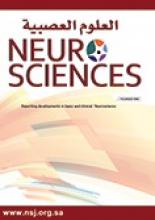Article Figures & Data
Tables
Characteristics Variable Gender Male 46 (57.5) Female 34 (42.5) Average age, y (range) 55.53 (26-90) Age <45 years 21 (26.3) 45-55 years 19 (23.7) 56-65 years 20 (25.0) 65 years 20 (25.0) Stroke subtype Ischemic 75 (93.8) haemorrhagic 5 (6.2) Recurrence Not recurrent 62 (77.5) Recurrent 18 (22.5) Duration <1 year 32 (40.0) 1–2 years 29 (36.3) 3–5 years 11 (13.8) >5 years 8 (10.0) Comorbidities and risk factors Hypertension 59 (73.8) Diabetes mellitus 46 (58.7) Dyslipidemia 32 (40.0) Obesity 15 (18.8) Ischemic heart disease 13 (16.0) Smoking 12 (15 .0) Atrial fibrillation 7 (8.75) Rankin scale 0-2 points 46 (57.5) 3-5 points 34 (42.5) Values are presented as numbers and percentages (%).
Quality of life N Mean Median Min. Max. SD Energy 80 3.41 3.66 1.0 5.0 1.40 Family roles 80 3.74 4.00 1.0 5.0 1.34 Language 80 4.15 5.00 1.0 5.0 1.28 Mobility 80 3.37 3.66 1.0 5.0 1.43 Mood 80 4.07 4.70 1.0 5.0 1.53 Personality 80 3.73 4.00 1.0 5.0 1.36 Self-care 80 3.91 4.90 1.0 5.0 1.48 Social role 80 3.66 4.00 1.0 5.0 1.38 Thinking 80 3.84 4.33 1.0 5.0 1.39 Upper extremity function 80 4.01 5.00 1.0 5.0 1.48 Vision 80 3.75 4.00 1.0 5.0 1.37 Work/productivity 80 3.77 4.50 1.0 5.0 1.47 SS-QOL 80 3.72 4.02 0.98 4.90 1.02 N: number, Min: minimum, Max: maximum, SD: standard deviation,SS-QOL: stroke-specific quality-of-life
Age <45 years old 45-55 years old 56-65 years old >65 years old P-value Mean SD Mean SD Mean SD Mean SD Energy 3.54 1.22 3.40 1.44 3.43 1.54 3.28 1.47 0.95 Family roles 4.06 1.29 3.54 1.52 3.88 1.22 3.45 1.34 0.43 Language 4.62 0.82 4.38 1.28 3.78 1.48 3.82 1.35 0.08 Mobility 4.04* 0.99 3.32* 1.44 3.56* 1.42 2.55* 1.48 0.007* Mood 4.17 1.15 3.84 1.47 4.44 2.05 3.83 1.33 0.54 Personality 3.71 1.43 3.63 1.45 3.90 1.35 3.68 1.29 0.93 Self-care 4.58* 0.81 3.98* 1.62 3.90* 1.52 3.17* 1.58 0.02* Social roles 4.06 1.13 3.64 1.67 3.48 1.23 3.45 1.45 0.46 Thinking 4.06 1.08 3.70 1.57 4.06 1.40 3.53 1.50 0.53 Upper extremity function 4.68 0.71 4.05 1.59 3.84 1.69 3.45 1.59 0.05 Vision 3.95 1.25 3.42 1.79 3.95 1.32 3.68 1.08 0.57 Work/productivity 4.60* 0.78 3.35* 1.77 3.90* 1.36 3.20* 1.48 0.008* SS-QOL 4.13 0.56 3.65 1.25 3.76 1.05 3.32 1.02 0.08 SD: standard deviation, SS-QOL: stroke-specific quality of life, *p-value is significant at <0.05
Type N Mean SD P-value Energy Ischemic 75 3.48 1.36 0.094 Haemorrhagic 5 2.40 1.67 Family roles Ischemic 75 3.77 1.31 0.356 Haemorrhagic 5 3.20 1.78 Language Ischemic 75 4.17 1.27 0.572 Haemorrhagic 5 3.84 1.49 Mobility Ischemic 75 3.43 1.41 0.191 Haemorrhagic 5 2.56 1.50 Mood Ischemic 75 4.17 1.49 0.029* Haemorrhagic 5 2.64 1.47 Personality Ischemic 75 3.80 1.33 0.071 Haemorrhagic 5 2.66 1.49 Self-care Ischemic 75 3.98 1.44 0.137 Haemorrhagic 5 2.96 1.93 Social Role Ischemic 75 3.73 1.35 0.075 Haemorrhagic 5 2.60 1.51 Thinking Ischemic 75 3.80 1.41 0.305 Haemorrhagic 5 4.46 0.76 Upper extremity function Ischemic 75 4.07 1.46 0.185 Haemorrhagic 5 3.16 1.80 Vision Ischemic 75 3.72 1.40 0.462 Haemorrhagic 5 4.20 0.83 Work/productivity Ischemic 75 3.87 1.45 0.023* Haemorrhagic 5 2.33 1.02 SS-QOL Ischemic 75 3.77 1.01 0.094 Haemorrhagic 5 2.98 0.87 SS-QOL - stroke specific quality of life scale, SD - standard deviation, *P-value is significant at <0.05
Recurrence of stroke Recurrent (n=18) Non-recurrent (n=62) P-value Mean SD Mean SD Energy 3.38 1.37 3.42 1.41 0.92 Family roles 3.48 1.05 3.81 1.41 0.28 Language 4.04 1.11 4.19 1.33 0.67 Mobility 3.47 1.35 3.35 1.45 0.75 Mood 3.32* 1.37 4.29* 1.51 0.01* Personality 3.59 1.48 3.77 1.33 0.62 Self-care 3.58 1.58 4.01 1.45 0.28 Social roles 3.05* 1.63 3.84* 1.25 0.03* Thinking 3.53 1.57 3.93 1.33 0.28 Upper extremity function 3.78 1.53 4.08 1.48 0.46 Vision 4.07 1.40 3.66 1.36 0.27 Work/productivity 3.63 1.58 3.82 1.45 0.62 SS-QOL 3.49 0.90 3.79 1.04 0.28 SS-QOL - stroke specific quality of life scale, SD - standard deviation,*P-value is significant at <0.05
- Table 6
- Quality of life of the participants according to comorbidities and risk factors.
Comorbidities Hypertension 59 (73.8%) Diabetes mellitus 47 (58.8%) Dyslipidemia 32 (40%) Obesity 15 (18.8%) Ischemic disease heart 13 (16.0%) Smoking 12 (15.0%) Atrial fibrillation 7 (8.8%) Mean+SD P Mean+SD P Mean +SD P Mean+SD P Mean+SD P Mean+SD P Mean+SD P Energy 3.23+1.46 0.05 3.44+1.37 0.86 3.49+1.53 0.70 2.91+1.56 0.12 3.38+1.33 0.92 3.50+1.61 0.82 2.57+1.71 0.09 Family roles 3.51+1.43 0.01* 3.87+1.30 0.30 3.78+1.40 0.83 3.33+1.57 0.19 3.74+1.32 0.99 3.88+1.48 0.68 3.14+1.67 0.22 Language 3.99+1.41 0.06 4.20+1.24 0.72 4.08+1.44 0.66 3.97+1.32 0.54 4.15+1.22 0.99 4.50+0.66 0.32 3.54+1.91 0.18 Mobility 3.14+1.45 0.01* 3.29+1.45 0.54 3.33+1.54 0.81 2.62+1.35 0.02 3.30+1.34 0.84 3.84+1.46 0.22 3.26+1.86 0.82 Mood 3.98+1.68 0.37 4.28+1.64 0.14 4.30+1.84 0.27 4.40+2.32 0.36 4.21+2.44 0.72 4.63+2.40 0.17 2.65+1.49 0.009* Personality 3.58+1.44 0.11 3.86+1.37 0.30 3.84+1.53 0.55 3.26+1.37 0.14 3.30+1.46 0.22 4.08+1.36 0.33 2.71+1.49 0.03* Self-care 3.68+1.60 0.01* 3.91+1.47 0.96 3.75+1.56 0.41 3.69+1.63 0.51 3.83+1.34 0.81 4.40+1.23 0.22 3.28+1.83 0.24 Social roles 3.46+1.43 0.03* 3.77+1.37 0.38 3.64+1.42 0.91 3.76+1.46 0.77 3.46+1.35 0.56 3.86+1.60 0.58 2.60+1.50 0.03* Thinking 3.78+1.47 0.51 3.99+1.35 0.26 4.06+1.47 0.25 4.15+1.17 0.34 3.69+1.27 0.66 4.47+1.12 0.09 3.14+1.77 0.16 Upper extremity function 3.77+1.59 0.01* 4.08+1.42 0.61 3.87+1.62 0.48 3.66+1.54 0.31 4.07+1.30 0.87 4.40+1.40 0.33 3.42+1.81 0.27 Vision 3.50+1.45 0.005* 3.68+1.37 0.55 3.52+1.50 0.20 3.08+1.34 0.03* 3.89+1.11 0.69 4.30+1.21 0.13 2.85+1.57 0.06* Work 3.48+1.57 0.002* 3.73+1.46 0.76 3.82+1.50 0.83 3.15+1.63 0.06 3.56+1.42 0.56 4.08+1.36 0.44 2.71+1.60 0.04* SS-QOL 3.53+1.09 0.004* 3.77+1.00 0.58 3.71+1.16 0.95 3.45+0.99 0.26 3.66+0.92 0.82 4.10+0.99 0.16 2.97+1.34 0.04* P: p-value, SS-QOL: stroke specific quality of life scale, SD: standard deviation, *P-value is significant at <0.05






